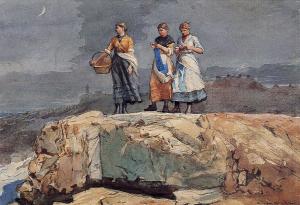 Ahh Homer Winslow, the great american. His greatness is out of the question here. But this particular painting of his, called ‘On the cliffs’ (AKA ‘where are the ships’) is a mistery to me. Such strange composition, 3 figures together in the upper center, the lower alf rocks. This is a very strange arrangement of elements. Almost no emphasis on the background, and only a hint of blue to tell us that this is happening by the sea. An yet such a powerfull effect on me. Such fascination I am unable to explain.
Ahh Homer Winslow, the great american. His greatness is out of the question here. But this particular painting of his, called ‘On the cliffs’ (AKA ‘where are the ships’) is a mistery to me. Such strange composition, 3 figures together in the upper center, the lower alf rocks. This is a very strange arrangement of elements. Almost no emphasis on the background, and only a hint of blue to tell us that this is happening by the sea. An yet such a powerfull effect on me. Such fascination I am unable to explain.
-
Recent Posts
Recent Comments
liveisanart on Why is this painting so f… Ric on Why is this painting so f… Archives
Categories
Meta

It is indeed an odd composition, breaking just about every rule of classical geometry. I see two main compositional elements — proportions of the blockings according to the Golden Mean (Golden Section), and the color keys. The rock is, itself, proportionally a ship, and the figures are standing on deck. The horizon division strengthens the allusion to a ship at sea. The absence of the middle ground forces you to look at the blue staccato notations, which are (again) proportionally distanced from each other according to the Golden Mean. The division between foreground and background is yet another Golden Mean measurement. Placement of the verticals —the figures and the distant dark cloud— are Golden Mean spatial repetitions as well as harmonies to each others’ location on the picture plane.
Homer experimented greatly with composition. One of his hallmarks. His sense of Baroque was very radical for his period, which was harshly rejecting the spatial and temporal conventions of the Baroque to that point (including Neoclassicism, an offshoot of the Baroque; Romanticism should be obvious). If you look closely at Courbet, you’ll see similar geometries as Homer’s here. Kindred spirits.
The idea of the ship analogy never crossed my mind. I wonder if Homer was thinking about it or if it came subconsciously. Thanks for such an informative commentary. I though this composition was perhaps a wimp (a fascinating wimp) on the part of Homer. It turns out it has a lot of work and study behind it. And thats even more fascinating.